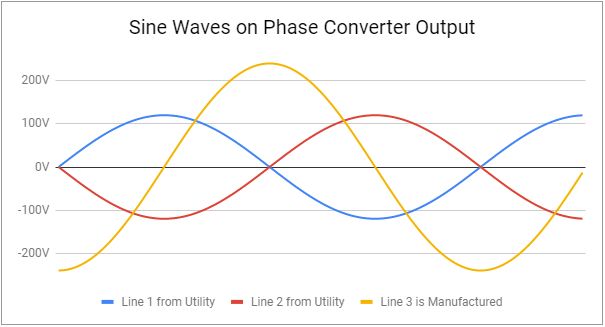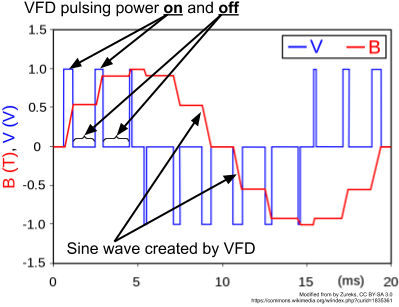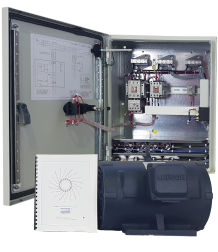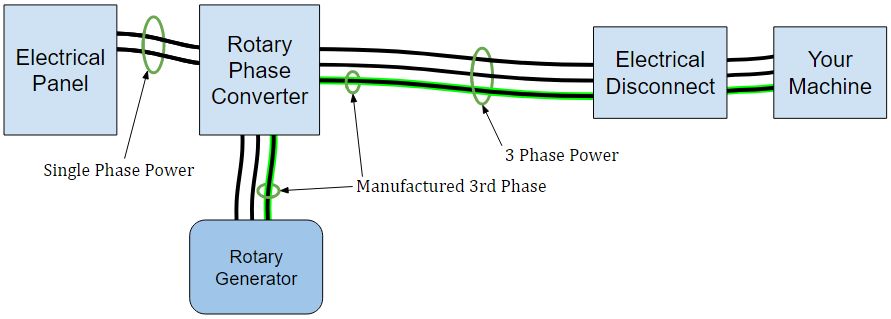My machine needs 3 phase power
We get calls daily from people who purchased a machine -- it’s a really awesome machine -- but it needs 3 phase power and their shop only has single phase. Most of the time, they didn’t realize they needed 3 phase until they went to hook up the machine and, well, couldn’t.
They need 3 phase, but they don’t really know much about it. Before jumping in to buy the first option, they want to know a bit more about how to convert 1 phase to 3 phase supply make sure that what they buy will work properly with their machine.
What options are available to convert to 3 phase power?
You are looking to convert from single phase to 3 phase because your shop only has single phase. Where do you even start? Here we’ve outlined the common solutions that are brought up.
1. 3-Phase Utility
The first thing you should do is check if 3 phase is nearby. It is possible that 3 phase is running on the power lines outside your building. Your utility company can tell you how far away the nearest 3 phase lines are.
If you’re in a rural area, a rough estimate is that the utility company will charge $10,000 per pole to bring it to you. A downside of investing in bringing the 3 phase utility to your shop is that if you move then you cannot take it with you. A benefit, however, is that you would not need a single phase to 3 phase converter.
2. Solid State Phase Converter
A solid-state phase converter is a device that produces 3 phase power by converting AC (sine wave) power into DC power, and then back to AC power. This conversion is accomplished through electronic rectifiers. There is an interesting reason why this is done. By creating a uniform and constant DC power supply, the solid-state phase converter can then take from this in a reliable way to produce the 3rd electrical AC sine wave. The 3rd electrical sine wave is what creates the 3 phase power (see the image below rotary phase converters section). This also allows the phase converter to offset the 3rd sine wave from the utility sine waves (see the image below). The 3rd phase needs to occur at a different time than the utility waves. By having a constant DC power supply, the phase converter can convert the DC back to AC in the proportion it needs at the time it needs it.
Examples of solid-state phase converters are variable frequency drives and digital phase converters. Both of these types of static phase converters are described in more detail below.

3. VFD
Variable Frequency Drives (VFDs) are designed to be connected directly to a motor. They are not designed to power a whole machine or multiple motors. The electrical output of a VFD is a pulse rather than a constant electric supply. This is called Pulse Width Modulation. The VFD will output pulses (blue lines in graph) so that the average of those pulses over time produces a sine wave (red line in graph). Motors are good with this but the control boards on your machine will freak out.
People usually buy VFDs for variable speed control of their motors or if they want to reduce the amps the motor draws when it starts up. This is called soft-starting and is done by ramping up the speed of the motor over time. An added benefit is that many VFDs do phase conversion. They are also the most cost-effective solution. If you have a single motor that you are trying to power, then this may be a good option.

About VFDs
4. Rotary Phase Converters

Rotary phase converters, also known as Roto Phase Converters, are a power supply. They are a 3 phase converter and can power a machine with a single motor or multiple motors. If you install a breaker panel, then you can power multiple machines, like in the connection diagram below.
Rotary converters have both a panel and an electrical generator (seen in the image below). When the rotary converter is on, then the generator is spinning. This generator is basically a specially designed electric motor with no drive shaft.
The rotary phase standby power consumption is directly related to the size of the electrical generator. This generator needs to continuously spin even when there is no load on the converter. The larger the rotary phase converter is the more power it will consume to produce the 3 phase electricity from single phase. If you have limited power available, you can eliminate this additional power overhead by using a digital converter. You can calculate the single phase breaker size you need using this calculator.
Rotary converters are a cost-effective option and are usually selected by individuals who have 1 or 2 machines, often in a home shop or commercial workshop.

About Rotary
5. Digital Phase Converters
Digital Converters produce high-quality power. If you have a CNC machine or a machine that requires quality power, then you will want to consider this.
On a rotary converter, when your machine is loaded down (eg. a table saw hogging through a large board) then a rotary phase converter’s voltage fluctuate. A table saw doesn’t care about this, but a CNC machine probably would. When you have a precision machine, the voltage imbalance and fluctuation that can occur in a rotary phase converter can cause the motors on your CNC machine to not perform ideally. This is where the digital converter really shines through. The digital converter has perfectly balanced power across the 3 lines.
A digital phase converter is a power supply. This means you can connect it directly** to your machine, or through a breaker panel if you want to power multiple machines.
**There should be an electrical disconnect (on/off) just before your machine.
Learn MoreAbout Digital
6. Rent a Phase Converter
Occasionally, people call saying that whatever 3 phase solution they have is broken and they urgently need to get an alternate solution in place. You can rent one of our converters to get back up and running right away. With a temporary solution in place, you can then take a look at your options to make a rational decision.
We have a couple different phase converter sizes that can be rented. We can ship it to you on a pallet or you can pick it up if you live near by. Most people will leave the phase converter sitting on the pallet in their shop. They will run their single phase input in (2 wires) and get their 3 phase output (3 wires).
If you need a rental then call us and we can figure out how to get it to you fast.
Contact UsWhat's best for my machine?
- If you have a 3 phase utility already in your building, then you don’t need a phase converter.
- If your machine uses computer controls (eg. CNC), then a digital converter will provide you with the best possible power.
- If your machine does not use computer controls (eg. table saw, edge bander), then a rotary is a good option.
- If you are powering a single motor or if you need to control the speed of that motor, then a VFD can be used.
- If you are looking for a short-term option while you fix something, then a rental of our digital converter should be considered.
We provide all these options, except for the service from your utility company. This benefits you because we provide the right solution, not just the solution we carry. We stock in our Edmonton warehouse many digital converters and VFDs, we have been manufacturing rotary converters for 35 years, and we usually have rental phase converters available.



